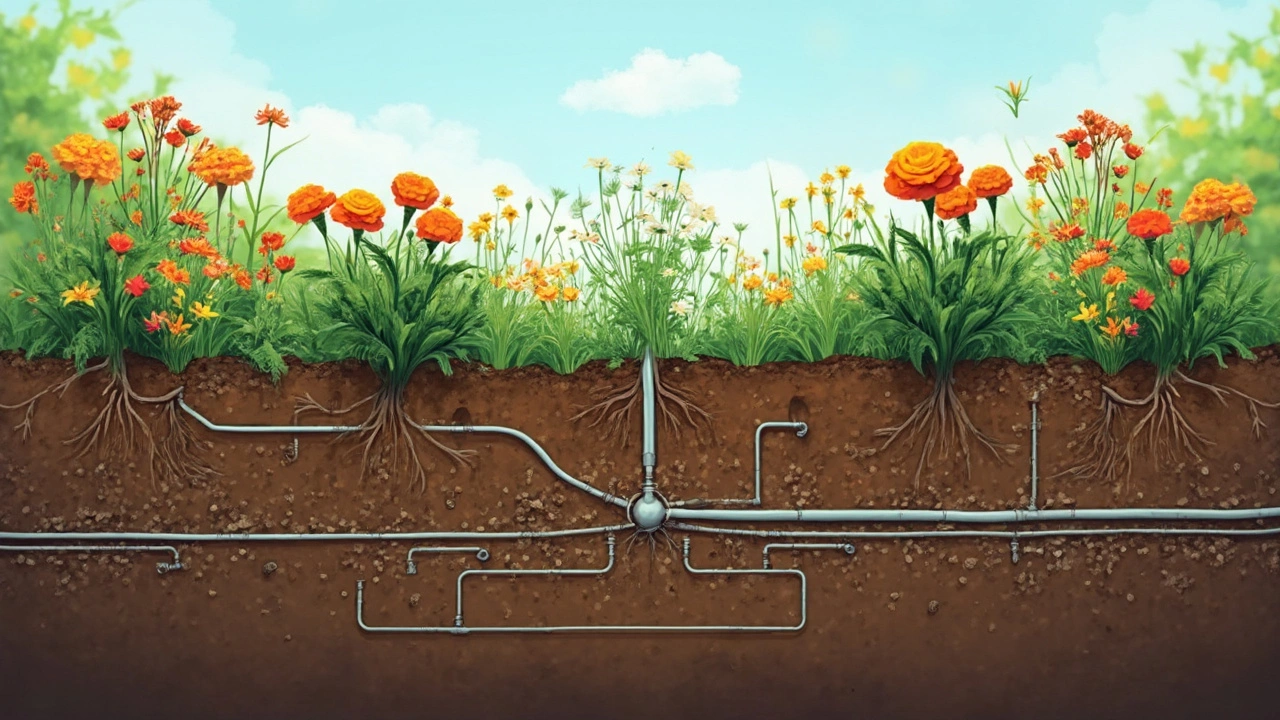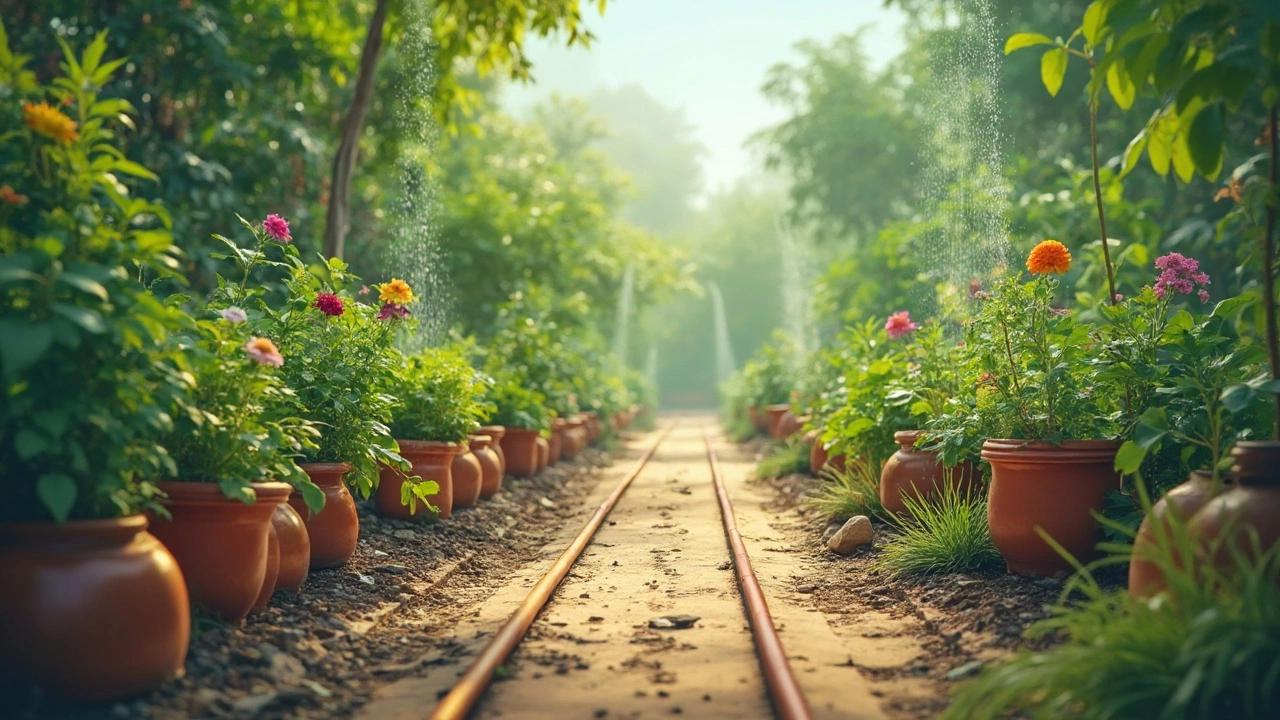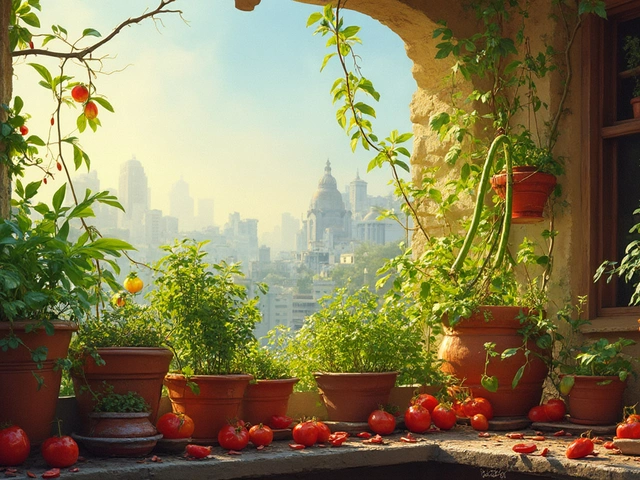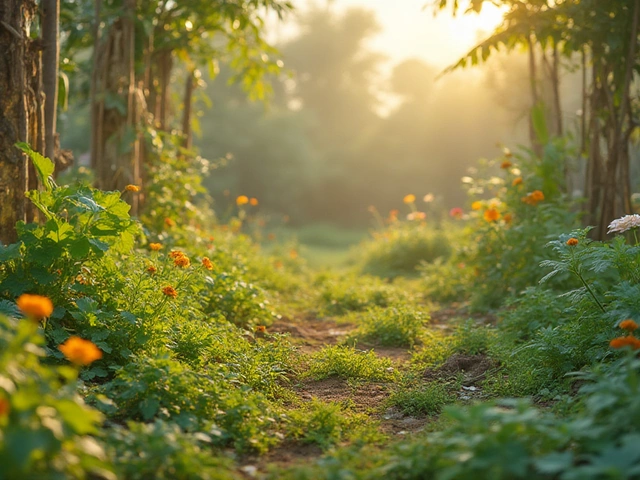Ever found yourself wrestling with hoses in your garden, struggling to keep everything hydrated just right? If so, drip irrigation might already be on your radar. It's like a secret weapon for green thumbs, delivering water directly where plants need it the most. But then the million-dollar question pops up—should you bury the system or not?
Well, keeping it above ground means easy access and a chance to spot any hiccups like leaks right away. Think about those times you wished you could fix something without digging up half the garden. It’s super convenient, especially if you’re not quite ready to commit to a permanent setup.
On the flip side, burying the system hides it from view, dodges sun damage, and reduces the risk of tripping over hoses. It sounds pretty neat, especially if aesthetics and safety are high up on your list. Plus, in some climates, burying might protect the system from frost.
- Understanding Drip Irrigation
- Benefits of Burying the System
- Challenges of Underground Installation
- DIY Tips for Your Garden
Understanding Drip Irrigation
All right, let’s break it down. Drip irrigation is like having your own little rain cloud, delivering water directly to your plant roots. You set up a system of tubes that transport water from a source, whether it's a tap or rain barrel, to the specific spots you want watered. It’s super efficient because you lose less water to evaporation—score one for the environment and your water bill!
These systems are incredibly flexible. You can customize them to fit any garden layout, whether you're growing veggies in the backyard or keeping things green on a balcony. Got hanging baskets or a sprawling garden bed? There’s a drip solution for that. The system usually features tiny emitters that drip water slowly and consistently, ensuring plants get just the right amount.
Why all the fuss about drip irrigation? It's mostly because it’s a giant time-saver. Imagine not having to stand around with a hose for ages. Plus, it minimizes weed growth since only the desired plants get the water, not the whole yard.
But before you jump in, there’s a bit of setup involved. You’ll need a filter to keep gunk out of the lines, especially if your water source isn’t perfectly clean. Also, pressure regulators come in handy, preventing damage that high-pressure water can cause.
- Efficiency: Saves water by 30%-50% compared to traditional methods.
- Flexibility: Adaptable to all garden types and sizes.
- Convenience: Automated systems can do the watering while you kick back.
After installation, maintaining the system is relatively straightforward—just check the emitters now and then to ensure they aren't clogged. Having a backup system is wise if you're using it in areas where water conservation regulations are strict or if you’re not always around to oversee the garden.
Benefits of Burying the System
So, you’re thinking about putting that drip irrigation system underground, huh? There are definitely some cool perks to doing that. First off, burying your irrigation not only keeps your garden looking neat and tidy but also spares you from dodging hoses while you’re out there digging up weeds. Aesthetics aside, there’s more to it.
When you bury the system, you’re giving it a big ole protection boost against the blazing sun. Sunlight can really do a number on hoses over time, making them brittle and prone to cracking. By keeping everything underground, you dodge that whole mess and potentially extend the system's lifespan.
Oh, and let’s not forget about temperature control. If you live somewhere that gets chilly, burying your system can keep it safe from frost damage. This way, your garden stays hydrated even when Jack Frost comes knocking.
There’s also the efficiency angle. By positioning your irrigation right next to the roots, every drop of water is put to good use. No more watering the air or having it evaporate before it even hits the dirt. Talk about water conservation!
Maintenance seems less of a hassle too. Once set up, you don’t have to worry about tripping over hoses or having kids—or pets—play with them. And if you’re gunning for a permanently svelte garden look, an underground setup might just be the ticket.
In summary, burying your drip irrigation is like putting on garden armor. It keeps things out of sight, protects them from the elements, and boosts overall efficiency.

Challenges of Underground Installation
Deciding to bury your drip irrigation system isn’t just a set-it-and-forget-it deal. There are some real challenges you gotta think about before grabbing the shovel. For starters, digging trenches can be a big job, especially if you have a rocky or root-filled garden. It’s like wrestling with Mother Nature herself.
One of the main headaches is the potential for clogged lines. When you’re laying the system underground, dirt and debris might sneak into the emitters. It’s not always easy to spot these clogs until your plants start looking thirsty and miserable. Regular checks are a must, which can be trickier when everything's buried.
Also, there’s the issue of maintenance. If a tube splits or an emitter gives up, you’ll be doing some digging to fix it. Imagine trying to locate a tiny leak under inches of soil. It’s much harder than just patching up something above ground.
Let's not forget about cost. The initial investment can be higher due to materials like soil pipes and protection sleeves meant to fend off the occasional rogue root. Plus, if you decide halfway through the season that the layout needs tweaking, making those changes underground isn’t a walk in the park.
However, these challenges don't mean burying is a no-go. With a bit of planning and the right gear, many gardeners find it's totally worth the hassle. But it's definitely wise to go in with your eyes wide open.
DIY Tips for Your Garden
Setting up a drip irrigation system in your garden doesn't have to be complicated. With a few handy tips, even a newbie can get the hang of it. Let's break down the essentials to get you started.
First off, figure out the layout of your garden. Have a clear picture of where your plants are and how much water each needs. Sketch it out if you have to. This step makes it easier to plan where the hoses will run.
Once you have a layout, it’s time to gather your materials. You'll need hoses, emitters, connectors, and a timer. A timer is like the brain of your setup, making sure your plants get watered at the right time, even when you're not around.
- Choose the Right Hose: Depending on your garden size, choose between a mainline for larger gardens or individual emitters for smaller areas.
- Mind the Water Pressure: If your water pressure is too high, consider using a pressure regulator. It helps to keep your system from blowing a gasket.
- Space the Emitters Properly: Plants like tomatoes need more water than your average herb garden. Make sure the emitters are spaced according to your plant’s thirstiness.
- Test the System: Before burying or leaving your system out for the sun to pound on, give it a test run and make sure everything flows smoothly.
For those considering going underground with their system, here's a quick reminder. Burying the hoses provides more durability against UV rays and lawn mowers but remember to check for obstructions like rocks or roots before digging. A depth of about 6 inches should do the trick, keeping the hoses safe and out of sight.
Lastly, keep an eye on your drip irrigation system for any leaks. Even the best systems need a little love and maintenance. With these straightforward tips, your garden will soon be the envy of all.





